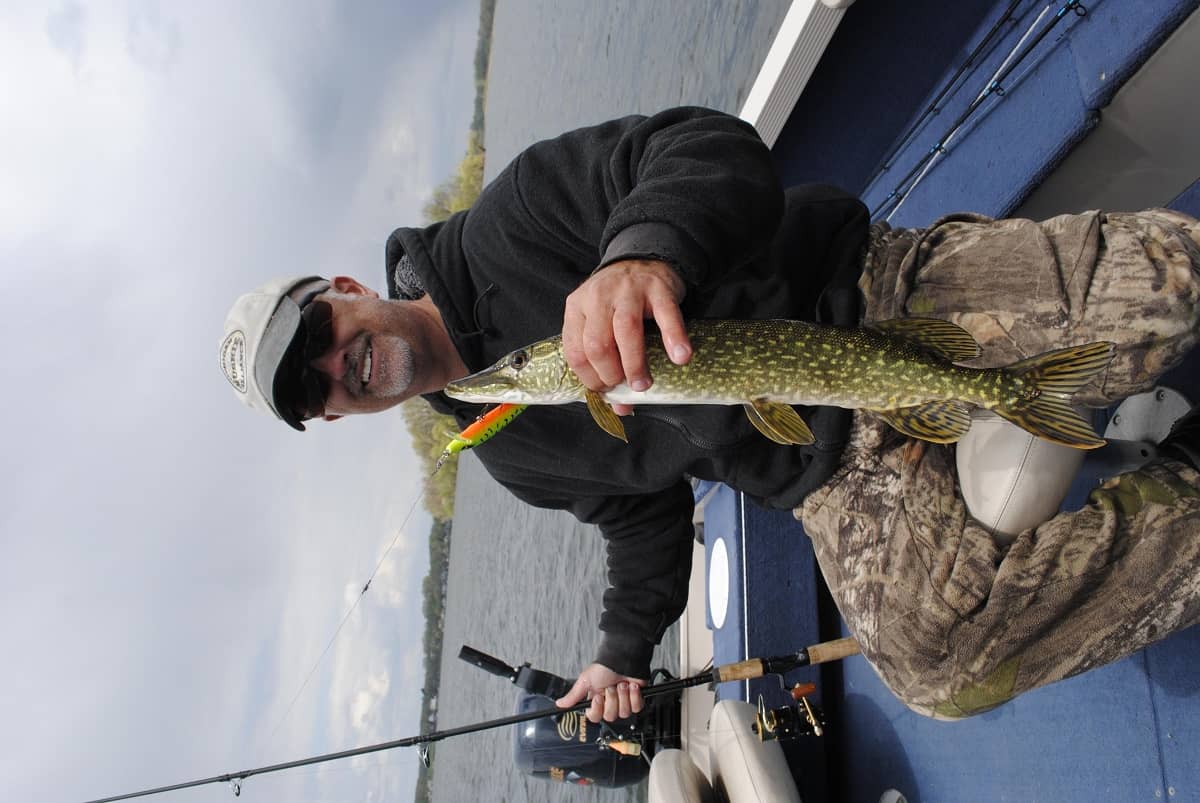Pursuing Pike on a Michigan Inland Lake
Bob Gwizdz 05.22.14

When I was a lad, northern pike were among the most popular game fish here in Michigan, often mentioned in tandem with bass. Northerns were the clear favorite of those who wanted to catch big fish. Except for those few muskies that were being caught in those days, pike were all that.
Over the decades, the popularity of pike declined, for a number of reasons—including the fact that they were no longer the big fish in the pond. Once Michigan’s Great Lakes salmon program got cooking in the ‘60s, it became common for anglers to tussle with fish weighing in the double digits. Further, as bass fishing grew in popularity (a phenomenon that shows no indication of ebbing), pike were gradually forgotten.
But not by everyone.
Joe Bednar still thinks pike offer everything anglers could want in a fish: they are aggressive predators that put up a good fight and are willing to take all manner of artificial lures. They’re relatively easy to find (think weed beds) and are active year-round, being one of the most popular game fish for ice fishermen. Except for a short period when they are off-limits (March 15 to the last Saturday in April in the Lower Peninsula, March 15 to May 15 in the Upper Peninsula) to anglers, they are catchable almost all the time—and they never go off-limits in the Great Lakes and connecting waters of the Lower Peninsula.
In the mid-1990s, the Battle Creek resident formed Pikemasters, a group of like-minded enthusiasts who felt that pike were not getting the respect they deserve as a game fish. Bednar’s group held regular club events across Michigan to share time on the water—and information—to further the fraternity of pike anglers.
I’ve known and fished with Bednar for years, so when he recently invited me to spend a day casting for the toothy critters on a small Barry County lake, well, I was all in. Bednar’s only condition was that I keep the name of the lake to myself as pike are so naturally aggressive, they can be subject to overharvest in small bodies of water.

We started out on a brisk—there had been frost warnings the night before—May morning with no other boats on the lake. Bednar, who is adept at all pike-catching techniques, had decided we should spend the day casting; he immediately piloted his boat to a protected bay that was partly out of the wind.
We worked weed beds in anywhere from four to 10 feet of water. Bednar rotated through a wide variety of lures—spoons, bucktails, and jerk baits, all popular pike offerings—while I spent almost the entire day throwing a large (1-1/2-ounce) spinnerbait. About three hours into it, Bednar had me down three to zip (and all three of his fish came on floating/diving jerk baits). Then I caught two in a row.
I prefer spinnerbaits, not only because they are productive and they can be retrieved through the weeds better than most other baits, but also because their large-profile, safety-pin shape makes it difficult for the pike to inhale the entire lure, which happens frequently with smaller crankbaits and jerk baits. Steel leaders—which Bednar swears by—do a lot to alleviate lost lures, but I prefer to fish without a leader if I can get away with it.
We caught fish at a variety of depths; the key factor was weed growth and patches of cabbage (broad-leafed plants) produced better than anything else. The weed beds that came within a foot or two of the surface seemed to offer the best pickings.

The wind got to howling in the afternoon, which made it more difficult to stay on the weed beds with the trolling motor, but whenever we located a promising stretch of vegetation, we generally got a strike; we converted at least half of those into fish in hand. When we boated our 10th fish, I told Bednar I was happy. He wanted to give it one more go.
We decided to make one more drift past what had been a productive stretch of weeds. Bednar nailed a fish on a fire-tiger colored Rogue. I latched on to one (about 22 inches) on the spinnerbait. At the end of the weed line, I called it a day.
Twelve pike? Not bad for a forgotten fish, eh?
Bednar said the better pike fishing in Michigan is not on small lakes, where we fished, but larger ones. He touts the drowned river mouths along the west side of the state that connect to Lake Michigan, for instance. I agree; I’ve had good pike fishing on a number of them, most notably Muskegon Lake. Bednar mentioned Portage Lake, on the Keweenaw Peninsula, which connects with Lake Superior, as a quality pike fishery and, as I have fished it several times with excellent results, I concurred. He also said he likes rivers—because they get less overall fishing pressure—and I agree, though I noted that some of the best pike fishing I’ve had in rivers (the Betsie and the Pere Marquette, to name two) are in streams better known for steelhead and salmon. I believe that access to the Great Lakes makes a lot of difference; the Detroit River shines especially brightly.
Bednar said we should try it again in the summer, when the water temperatures have stabilized and we can troll effectively. I made one request of him: just tell me where and when.
For more information on Michigan fishing go to michigan.org. Click here to purchase a Michigan fishing license online.
This article was produced in partnership with Pure Michigan.

